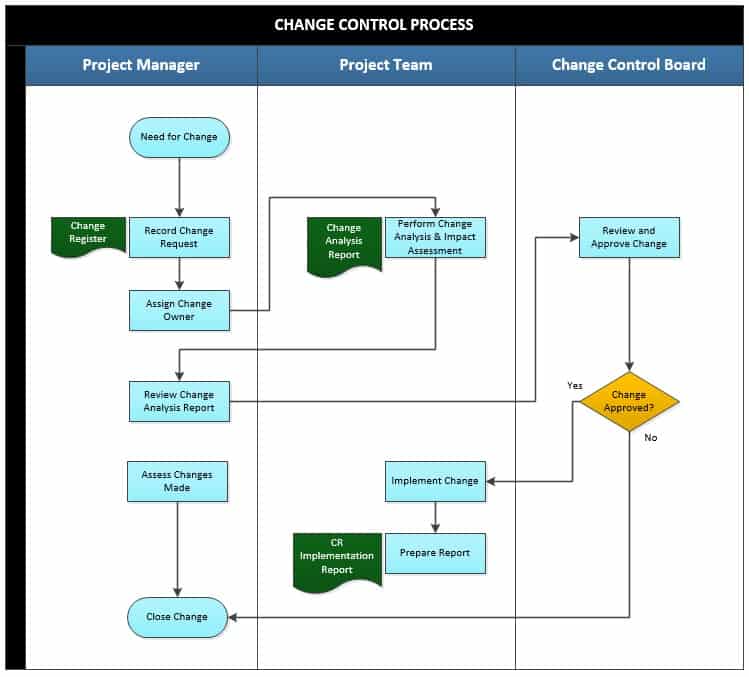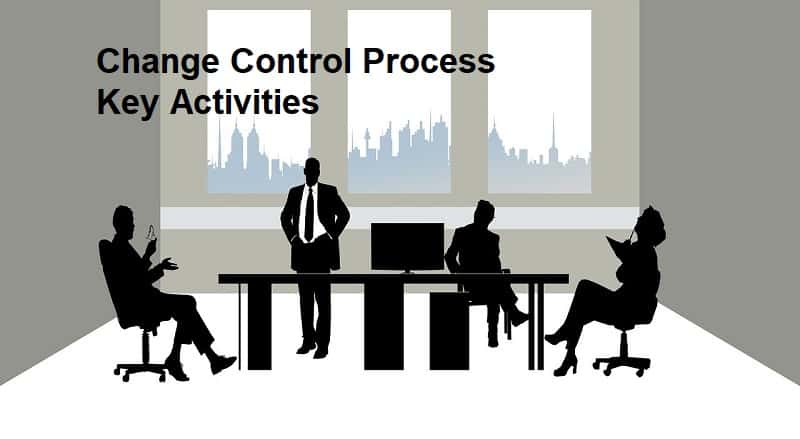The change control process is a fundamental part of project management that shouldn’t be overlooked. This is because changes may occur during any phase of a project life cycle. When they occur, they must be managed appropriately to ensure that the project’s success is not threatened. Changes are beneficial for a project because they help to streamline the project and align it with the strategic goals of an organization. Assessment should take place before any important decisions are made regarding the approval or rejection of a change. If this part is ignored, the organization is at risk because unnecessary changes may bring losses to the whole project in terms of wasting resources, time wastage, and losing money.
Therefore, the change control process is intended to track changes made within the project lifecycle and should be thoroughly explained and analyzed. Additionally, the process ensures that only the significant changes go through the approval and implementation process. The process also helps to avoid any unwanted protocols that may ruin the project such as misusing resources that may lead to disruption of the project.
The main aim of the change control process is to shield any unnecessary changes and all the important ones are recorded and don’t disrupt the project in any way, it should ensure that resources are used adequately. Below are the objectives of the change control process:
- To avoid any disruption caused by changes that cannot be managed
- To allow enough planning so that changes are implemented effectively
- To ensure that all changes made are documented and communicated.
- To make sure the project stays within its scope and not mismanaged
- To establish the main reasons for the change and put a value on it
- To identify the possible risks that may occur due to the changes
- To avoid negative effects brought about by the changes
- To make sure that unnecessary changes don’t reach the implementation and approval stage
- To make sure that all changes made are reviewed and analyzed
The change control board, project team, and project manager have to establish the boundaries of the change control process. The scope is important because these are the main stakeholders that actively participate in the change control process. Thus, the change control process covers the following:
- Assessing the changes made
- Documenting the changes made
- Reviewing and approval of the analysis report
- Documenting and recording the work done and its success
- Assignment of change to a change owner
- Implementation of the approved change request
- Identification of proposed changes
- Change analysis and impact assessment

1. Need For Change
Here, the objective is to communicate with the project manager about the need for change. The change request comes from the organization and some internal factors such as upcoming opportunities for a merger, new technology, or if the business gets a new direction through the senior manager. Some of the external factors driving the need for change include economic conditions, competition, and changes in the law. Therefore, all changes that were suggested should be identified.
2. Record Change Request
This activity involves documenting change requests. The suggested change has to be recorded including all the details like the need for change, timeframe, the reason behind the change request, conditions for its success, and the envisioned value. The person making an actual request should explain it so that it can be understood and clearly defined. Appropriate documentation should be done and expected by the project manager or the business. The project manager updates the change register with the requests for change. The register is inclusive of the change request and the decisions governing each of them. Thus, the output document in this activity is the Change Register.
3. Assign Change Owner
The main objective of this activity is to choose someone who will take the responsibility of clearly defining the change process and support it. A change owner is in charge of all the activities taking place in regard to the assigned change. He or she works together with the project manager on all matters relating to the assigned change. This is done through efficient planning and making sure issues are resolved adequately. It’s up to the project manager to appoint an individual and make him the change owner.
4. Perform Change Analysis And Impact Assessment
This activity aims to identify the good and the bad of the requested change. It requires determining things that need improvement for it to accomplish its role. The activity also identifies the possible risks and their effect on the project and its resources. Structured ways to analyze changes and assess their impact are determined. During this activity, the project team estimates the impacts of change and the risks involved. There should be an evaluation of the importance of these changes and how they are justified. The team also makes a summary of their findings in regard to the change analysis report. The project team takes up the role of defining the extent and variation of these changes according to the current and future states. The Change Analysis Report is the output document in this activity.
5. Review Change Analysis Report
After a proper comprehension of the analysis report, this activity should help evaluate the proposed change and find its possible effects and benefits. The report is supposed to show the resources required, the benefits, savings, and the cost benefits altogether. The activity also helps to determine any missing parts relating to the changes and they become open for suggestions. The project manager reads through the report and understands where the project team has made proposed changes and he corrects immediately. The project manager is allowed to seek clarifications on the suggestions made and indicate where necessary. After the project is done with the review, he hands over the report analysis to the change control board for review and approval of the requested change.
The objective of the change control board in this activity is to find the importance of the requested change, whether it is beneficial or not. The information found on the report has the reasons behind the changes and thus it has to be reviewed before any decisions are made. The activity will make sure that only the important changes go through the approval stage hence avoiding other unnecessary changes.
Thus, the change control board goes through the report to determine if the change requested is necessary and beneficial to the organization. It will then approve the change once they have established its importance to the project. After approval, the process moves to the implementation stage. If benefits are not identified at this point, the change request is denied and the process is closed. The board has the responsibility of rejecting changes that may jeopardize the project. The change control board may also postpone the implementation of the change for a later date in the future depending on the needs and circumstances at hand.
6. Implement Change
After the approval, the change needs to be planned, scheduled, and executed for the time frame requested on the report. This activity enables necessary actions that will bring benefits or the future as expected. There should be enough resources in terms of tools, equipment, and financing that will make the implementation stage successful. During implementation, the project team members actualize the requested change. Tasks and activities are shared among team members to ensure execution of the change is done within the schedule. Every activity to be done has to be planned appropriately according to the specific time stated.
An assessment is conducted to counter check the effected changes and if they were implemented appropriately. If there is any problem or incomplete work, the project team should have the problem resolved and the pending work completed. The objective is to ensure that work was done well and the outcomes will ultimately lead to success. The project manager should also go through the implemented changes and verifies if everything was accomplished properly.
7. Prepare Report
The objective of this activity is to document the success achieved by team members after the implementation stage. All the activities that took place during change implementation should be recorded in the report. This report will act as a reference for implementing similar or related changes in the future. It’s the role of the project team to report details involved in the change implementation process and how it was achieved. The benefits are to be documented and key details involving the change mentioned. Thus, the CR Implementation Report is the output document in this activity. The team hands over the report to the project manager.
Related Articles:
- Project Initiation Process: 6 Key Activities
- Project Planning Process: 7 Key Activities
- Project Execution Process: 8 Key Activities
- Project Monitoring and Control Process: 10 Key Activities
- Project Closing Process: 8 Key Activities
- Project Handover Process: 11 Key Activities
- Risk Management Process: 11 Key Activities
- Quality Management Process: 9 Key Activities
- Issue Management Process: 9 Key Activities
8. Close Change
This activity indicates that the change control process has come to an end. It is undertaken after reviewing and assessing the change to know if it was completed. Thus, the project manager closes the change process formally and the team members are relieved of their roles.
Conclusion
Change is inevitable and thus appropriate strategies must be put in place to deal with change whenever it is needed or requested. In order to track changes effectively, these activities must be adhered to. Besides, the change control process helps to approve changes that are beneficial and do away with those that threaten the success of a project.

